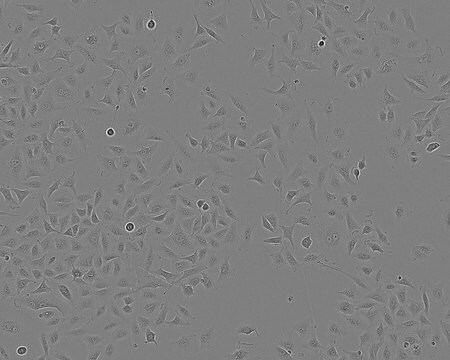3T3 L1 Cell Line from mouse
86052701, mouse embryo, Fibroblast-like
Synonyme(s) :
3T3L1 Cells, NIH-3T3-L1 Cells, NIH3T3-L1 Cells
About This Item
Produits recommandés
product name
3T3 L1 Cell Line from mouse, 86052701
Source biologique
mouse embryo
Description
embryo
Mode de croissance
Adherent
Caryotype
2n = 40; Aneuploid with unstable karyotype
Morphologie
Fibroblast-like
Produits
Not specified
Récepteurs
Not specified
Technique(s)
cell culture | mammalian: suitable
Conditions d'expédition
dry ice
Température de stockage
−196°C
Origine de la lignée cellulaire
Description de la lignée cellulaire
We would like to manage customer expectations with regard to the potential of the current 3T3 cell line stocks to differentiate into adipocytes. If you intend to use the cells for adipocyte differentiation please note: When cells are stimulated, using an appropriate protocol, differentiation may take several weeks to occur, e.g. 2 - 5 weeks, and the proportion of the population which differentiates can be limited. If you have previously used 3T3 cells from an alternative source we cannot guarantee the differentiation performance will be the same.
We are working to source a new stock of this cell line that has a higher rate of adipocyte differentiation potential which we aim to be able to offer in the future. When this is available we will update the cell line details on the website.
Application
Milieu de culture
Procédure de repiquage
Autres remarques
Certificats d'analyse (COA)
Recherchez un Certificats d'analyse (COA) en saisissant le numéro de lot du produit. Les numéros de lot figurent sur l'étiquette du produit après les mots "Lot" ou "Batch".
Déjà en possession de ce produit ?
Retrouvez la documentation relative aux produits que vous avez récemment achetés dans la Bibliothèque de documents.
Notre équipe de scientifiques dispose d'une expérience dans tous les secteurs de la recherche, notamment en sciences de la vie, science des matériaux, synthèse chimique, chromatographie, analyse et dans de nombreux autres domaines..
Contacter notre Service technique

